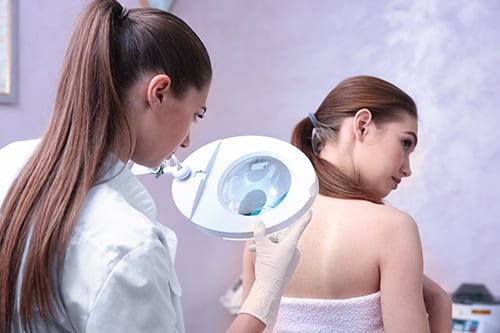

Moles, also called nevi, are benign growths made up of clusters of pigmented cells in the skin called melanocytes. They can appear anywhere on the body. They can be brown, pink, skin-colored, flat, or raised. Some are present at birth and others appear during childhood, adolescence, or early adulthood. Most moles appear before the age of 25-30.
The vast majority of moles are completely harmless. Sometimes moles may be irregularly shaped and may be called “dysplastic;” though dysplastic nevi are still completely benign. Very rarely moles may develop into melanoma; though approximately 80 percent of melanomas do NOT arise in pre-existing moles. A dermatologist is trained to help distinguish moles from dysplastic moles, melanoma, and other benign skin growths that may mimic moles. Sometimes a skin biopsy is required to confirm the diagnosis.
Benign-appearing moles do not require treatment, but patients may elect to have them removed for cosmetic or comfort reasons. Cosmetic mole removal is a simple procedure done in the dermatologist’s office using topical or local numbing. The entire procedure takes about 15 minutes depending on the type and number of moles being removed. Any method of mole removal will leave a small scar. However, choosing the best method of removal for the location and mole type and proper post-care will help give the best cosmetic outcome There are three ways in which moles may cosmetically be removed:
1) Surgical Shave Removal: this is a good option for smaller moles. A scalpel or special blade is used to shave the mole flat with the skin. The area will heal with a small scab that lasts a few days to a week and stitches are generally not needed.
2) Punch Excision: this is a good option for smaller moles that have a deeper component. A small instrument just slightly larger than the size of the mole is used to cut around the mole. Depending on the size of the mole, 1-2 sutures will be placed and need to be removed in 1 week.
3) Surgical Excision: this is a good option for larger moles, moles with a deeper component in the skin, or moles in cosmetically sensitive areas. A scalpel is used to cut around the mole in the shape of an ellipse. A line of stitches is placed to bring the skin together.
Other methods of mole removal include laser removal, electrodesiccation, or liquid nitrogen freezing of moles. We generally do not regard these as optimal treatment options for mole removal as they can distort the pathological and clinical architecture of the mole and the moles are more likely to recur. If the mole recurs after having this treatment, it can appear atypical and be concerning for an atypical mole or even melanoma, even if it is not. Therefore, we advise against these treatment methods.
It’s important you see a board-certified dermatologist who has expertise in distinguishing benign moles from other growths and to best direct your care.
Book a consultation with one of our board-certified dermatologists at our upper east side office.
Their knowledge and extensive experience allows them to deliver results you’ll love. To schedule your appointment call (212) 288-8222. or click here.
Make your skin a priority with our leading Upper East Side Medical and Cosmetic Board-Certified Dermatologists.
Book Now